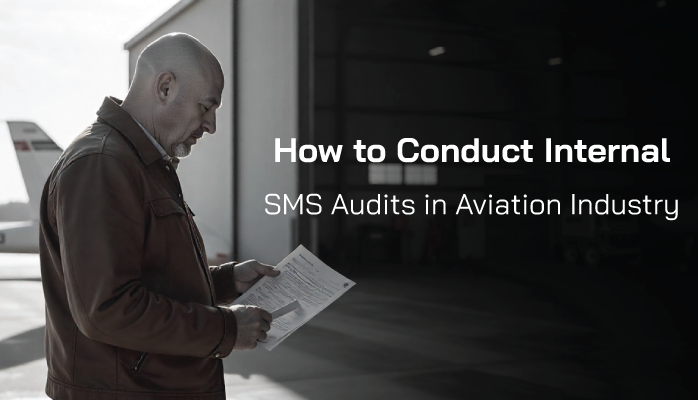What Are Internal SMS Audits in Aviation, and Why Conduct Them

Internal SMS audits are an extremely important element in verifying the performance of every aviation safety management system (SMS). They’re also a neglected process in a surprisingly large number of smaller operators' SMS risk management schedules.
Just ask yourself, when was the last time you performed an internal audit on your aviation SMS implementation? Let’s also be clear about what we mean when we say “audit”, as this word is thrown around loosely.
An internal audit:
- Is not a regular review process (as in, reviewing previously managed safety issues);
- Is a specific type of activity that aviation service providers will perform once or twice a year; and
- Is a best practice for external audit preparation, such as an impending audit from an oversight agency.
Related Aviation SMS Auditing Articles
- Real Difference Between an Aviation Safety Audit vs. Inspection
- How to Create an Aviation SMS Audit Plan
- Audit Checklist: 10 Things to Prepare for Aviation SMS Audits
Who Performs Internal Aviation SMS Audits
In short, conducting internal audits is similar to an audit conducted by regulatory compliance authorities, except you are in control of:
- Who conducts the internal audit;
- What you are auditing; and
- Your auditing format.
You might:
- Hire a third-party SMS consulting company to lead your internal SMS audit;
- Conduct the audit with trusted company employees outside the safety department; or
- Perform audit with a combination of third-party and trusted employees.
In very small organizations without quality assurance (QA) departments, a safety manager may conduct the internal SMS audit. As those of you who work in small organizations, managers are accustomed to wearing many hats. It is very common for a safety manager to be a full-time pilot or maintenance personnel. The role of safety manager in very small organizations is simply another "extra duty" that is assigned to an employee with good organizational skills.
Beyond this, here are the basic elements needed to conduct internal SMS audits in the aviation industry.
Gather Auditing Checklists

Internal audits should be performed with an aviation SMS audit checklist that has been prepared by a standards-setting organization, such as IATA, IS-BAO, or the Flight Safety Foundation. Alternatively, if you can acquire auditing checklists from your civil aviation authority, this will be the best option, as CAAs SMS auditing checklists generally:
- Provide guidance;
- Align with ICAO's SMS standards; and
- Ensure that audits are consistent, as well as thorough.
As stated, SMS audit checklists are generally provided upon request by oversight agencies before they audit your organization's SMS implementation. If you don't have the checklist, ask your aviation SMS inspector to provide the checklist to serve as a preparatory tool. This request may save you some considerable time preparing for the audit.
While you could use an SMS auditing checklist from another source, I'd acquire the one from your CAA as their checklist must align with the ICAO standards that their agency is obligated to follow when auditing your company. All member states the answer to ICAO, even the FAA. This does not mean that your CAA can not have higher standards than ICAO. Some do.
Likewise, you can create your own auditing checklist based on company standards. For example, an airport, airline, or other aviation service provider might walk through the FAA's Advisory Circular and create checklist items based on the most important SMS elements highlighted in the Circular. Smaller companies are most likely to create their own checklists when they see that their small size precludes them from demonstrating data-intensive safety performance monitoring capabilities, for example.
Related Aviation SMS Auditing Articles
- Aviation Safety Audits 101: Prep and Pass - With Examples and Checklists
- 5 Ways to Avoid Common Aviation SMS Audit Findings
- 9 Best Strategies for Aviation Safety Audit Preparation [Free Audit Checklists]
Create Auditing Team
Audits are best performed in teams. Team members should be trusted employees in your company, such as
- Veteran front line employees;
- Members of the safety team (smaller organizations);
- Operational department heads (auditing areas outside their departments); or
- Other trusted managers.
Each team member should be charged with evaluating a particular area that they are familiar with. Your audit team's reliable performance is where checklists demonstrate their undeniable importance. SMS auditors/inspectors don’t necessarily need to be experts in regulatory compliance rules and standards – they only need to have a clear checklist to follow.
The scope of each team member’s responsibility will probably vary depending on their experience and knowledge. Having operational experience is certainly a benefit for any SMS auditor; however, you cannot be assured that inspectors from your CAA will have operational experience. This is obvious if you have heard as many auditing "horror stories" as we have heard.
In any case, the audit team leader must know the capabilities of each audit team member. You might charge one team member with an entire section of the audit, and charge another member with a very specific set of checklist items based on a team member's educational background or previous work experience.
Review Previous Audit Findings
One of the most common use case scenarios for conducting internal SMS audits is to prepare for an impending audit by an oversight agency. The implication here is that you want to ensure past audit findings are now in a state of compliance.
Regardless of the reason for the internal audit, safety managers should review past audits and become familiar with the findings, concerns, and other comments. This information will then be used to
- Inform the audit team what particular areas of the audit to pay closer attention to;
- Compare with the internal audit results to establish any areas of repeat non-compliance; and
- Give you a general idea of what results to expect (no surprises).
Related Aviation SMS Auditing Articles
- How to Audit Previously Managed Safety Issues in Aviation SMS
- SRM-SA Aviation SMS Audit Preparation - 4 Free Checklist Templates
- What Are Static & Dynamic Components of Aviation Safety Auditing?
Tips for Conducting Internal Audits
Internal audits are not formal audits. The team conducting the audit should keep in mind the fact that an internal audit is as much a discovery tool as it is an exploration and assessment of “how the SMS implementation is performing.” Doing some of the following will help keep the internal audit process flexible:
- Making sure audit team members are trained and understand the terms in the checklist that are being used;
- If a team member is unsure about a particular item, they should never make “their best guess”;
- If unsure, always note or mark that item as incomplete, so that safety management personnel or some other review team can evaluate this item later;
- If possible, keep deadlines flexible so that audit team members are thorough with their assessment and not motivated to pencil-whip the audit to meet an imagined fixed deadline;
- Notify all employees of upcoming internal audit;
- Create an audit “plan” or schedule, so that audit team members and employees know what is happening and when.
The long and short of it is to keep stress at a minimum, take your time, and remain as organized as possible.
Review Audit Findings, Concerns, and Unsure Areas

Once the internal audit is complete, the safety manager or committee should follow up by doing the following (and in this order):
- Review all areas where team members “weren’t sure” and complete the audit;
- Review all findings and concerns;
- Verify that those findings and concerns are legitimate and properly marked, such as all findings are findings and not concerns, etc.;
- Create a corrective action plan;
- Process the audit findings and concerns much like in any other safety issue going through your aviation SMS' risk management processes, including tracking corrective actions and preventive actions (CPAs); and
- Once those CPAs are implemented, re-evaluate that area of the aviation SMS to ensure that compliance is now met.
The above steps are the more or less standard operating procedure for any audit, in any industry.
Related Aviation SMS Auditing Articles
- 4 Tips for Passing Aviation SMS Audits - With Free Resources
- How Often Should You Conduct Aviation SMS Audit
- 3 Traits Good Aviation Safety Auditors Share
Final Thought: Choosing Employees vs Third Party to Conduct Audit
Choosing a third party to conduct your audit has some pros and cons.
PROS:
- Outsiders tend to be more objective;
- Test how organized and easy it is to maneuver through your aviation SMS documentation (which the oversight agency will have to do); and
- Can be more thorough, as audits are the third-party’s specialty.
CONS:
- Less control over how they conduct audit;
- Can be less thorough if the third party doesn’t have much experience;
- Auditor may feel compelled to tell the operator "good news" in hopes of earning repeat business; and
- It costs money.
For the most part, creating an audit team internally will suffice. However, there may be situations where hiring a third party to evaluate your aviation SMS implementation can also be very beneficial, such as when preparing for major oversight audits.
These safety audit checklists should give you a solid idea of what good audit checklists look like.
Last updated August 2025.








